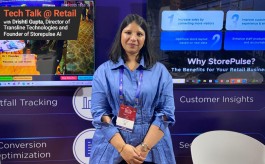Cracking the regional retail opportunity
By N Jayalakshmi | September 08, 2025
With money to spend and a keen desire to resonate with their aspirational customers, regional retailers often leave no stone unturned in their quest to offer the right store experience. Shyam Sunder K, Founder, Principal Architect & MD - 4Dimensions Retail Design, unboxes the dynamics of working in the regional retail space, in this conversation with Retail4Growth.

India’s retail sector is as layered as it is dynamic, and is certainly on the growth path, according to industry reports. Quietly driving this growth are traditional/regional retailers across the country. According to a recent report by Redseer Strategy Consultants cited in an article by the Financial Express, regional players are set to control over 70% of India’s retail sector, which according to the report is on a massive growth trajectory, expected to exceed $1.6 trillion by 2030.
For the industry supporting retail - comprising retail architects, store designers and store solution providers - regional retailers, many of whom are traditional in their formats, offer promising opportunities.
Four Dimensions Retail Design, which is all set to complete 25 years in the industry soon, has been one of the forerunners when it comes tapping the regional retail space in India. Shyam Sunder K, Founder, Principal Architect & MD - 4Dimensions Retail Design, unpacks some of the dynamics of traditional retail in India in this conversation with Retail4Growth.
Value and Exclusive Premium formats driving growth
Shyam begins by explaining how regional retail reflects the overall national trend of ‘Value’ and ‘Premium’ categories driving growth, with the mid-premium on a sluggish growth mode. “If you look at the overall trend, it’s the mid-premium category that is hit hard, and the same is reflected in regional retail. But the good news is that in regional retail, the mid-premium segment comprises a very small part of the market, with a majority of the stores being in the Value Retail category, which drives volumes. Even the mid-premium customers would opt for the Value category in regional markets, as the latter gives them better value for money. So, 70% of the regional retail focus is on the Value customers.” The premium category in regional markets, he says, is mostly driven by exclusive/specialty boutique stores focused on Weddings, Furniture, etc.
Leveraging close understanding of customers
Some of the regional players, particularly in segments such as fashion, are in direct competition to national brands, but in a country like India where the aspiration levels across tier 3 and 4 markets are consistently growing, there’s always room for more. As Shyam says, “Most of these regional brands are very clearly focused on penetrating the tier 2, 3 and 4 markets and are very clear about their positioning and focus segments. But most importantly, their understanding of the local customers is much higher compared to most national/corporate brands, and that’s where they gain their edge in the regional markets.”
The figures speak for themselves
The opportunity in regional retail market is seen in the spends by many of the large regional retail chains. As Shyam says, the average spends very often amount to Rs 2,500-3,500 per sq feet, but the interesting part is that the average square feet area of these store is often not less than 15,000-20,000 sq feet with store spaces often spanning 50,000 - 1 lakh square feet. “Most of them have massive stores, and the average turnover of even the smaller players is at least Rs 500 crore. So, there’s huge opportunity there.” A store project worth Rs 25 to 30 crore, is thus not uncommon in the regional market, given the scale of the stores and the retailers’ ability to spend.
Adapting to resonate with young shoppers
As Shyam shares, most of the regional retailers, including the first-generation ones, are also well exposed to international standards, having travelled globally. “They go and see what is happening outside and when they go out, they don't just do sightseeing. They visit a lot of retail stores and study the latest trends,” says Shyam. Also, with the second/next generation coming in and taking over the business, the need to change, keep up with the times and resonate with the millennial shoppers, is very high. “Many of these business owners send their children abroad for their higher education, so when the next generation takes over the reins of the business, they come with a fresh approach based on their global exposure. The readiness to change is thus very high,” explains Shyam. The crux of it, as he points out, is the growing need among regional retailers to connect with young shoppers- to engage and communicate. And this reflects in their approach to store design and the kind of experience they seek to offer in their stores, which in turn translates into their spends on the stores.
Speedy decisions & project completion
Shyam also points to the speed with which projects are completed and handed over because of the quick decisions. “Very often entire projects are completed in just 6 months, including design and execution, and this is because, unlike in a corporate, all decisions are centralised and taken by the top management. So even when there are changes, they come from a single source, unlike in a corporate where there are multiple layers of hierarchy and therefore multiple feedbacks to deal with. So, a lot of time can be saved.”
Approach to in-store tech
With high aspiration levels and a pressing need to modernize their store experience to resonate with their shoppers, regional retailers also make sure to invest in technology to improve their store operations and efficiency. Shyam gives the example of a leading retailer, who invested in the right technology to address the issue of price tag tempering by customers. “This retail chain, which has stores starting from 30,000 sq feet area of space, faced the issue of customers removing price tags from their merchandise and adding their own, since these were pinned to the sarees. To address this issue, the company adopted a technology by which the entire saree is scanned with a large scanning machine and the original price is displayed. Thus, there is no way to tamper with the price tags or change it. This kind of technology is not commonly used.”
He also talks about how some of these retailers use technology for billing and documentation purpose, which ensures easy tracking of invoices by partners. “Since everything gets into their system, it’s very easy for us to track bills and stay informed regarding the status of payment.”
But while technology adoption for back-end processes is quite high in regional retail, when it comes to the integration of customer facing, experiential technologies, there is still a long way to go. According to Shyam, this is not restricted to regional retail, but a reflection of the common overall trend in Indian retail. “Today, there are not many brands that have successfully adapted customer facing technologies across their stores. Barring possibly AZORTE, many brands have tried, but failed, particularly in scaling tech adoption across large number of stores. In such a large, organized retail market, if there is only one brand that we can think of when it comes to using customer facing experiential technologies in a large way, how can we expect regional brands to go big with their front-end tech investments?”
Moreover, as Shyam says, in the regional market, the focus is on offering better service, in keeping with the customer expectations. Thus, as in the case of the metros, the requirement in regional markets is for purposeful technology that can aid better purchase decisions.
Expanding and raring to go
With many regional retailers expanding across their region, penetrating tier 3 and 4 markets with very clear roll-out targets, supported by a clear focus and close understanding of market pulse, there’s no stopping the growth of regional retailers. For retail designers like Four Dimensions, regional retail market offers the opportunity to apply a lot of their learnings and experience to drive tangible benefits for the retailers. Says Shyam, summing up his insights, “About 8 years back we took the decision to tap the regional retail market, and it has paid off well. Of course, regional retail comes with its own dynamics, expectations and ways of working, and demands a certain approach to work. But if you can crack it, then it is certainly worth the effort. “









Comments